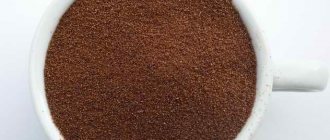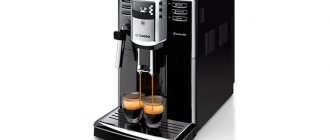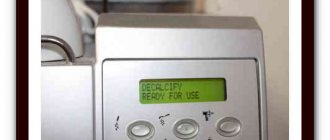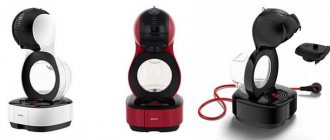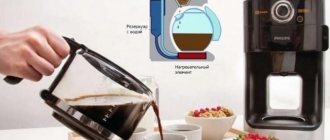Why fight scale?
The problem of descaling a coffee machine is very acute. The presence of hard water can damage both expensive and cheaper equipment. Limescale is a difficult task, but solvable. Descaling procedures need to be carried out regularly. You should not even attempt to select water for coffee; preventive maintenance cannot be avoided anyway, since the plaque, penetrating inside the device, envelops the heating element with a nasty white layer. The result of this is unjustified energy consumption, an increase in the brewing time of the drink, and in the future – breakdown of the coffee machine.
Cleaning deposits from a coffee machine is possible without much effort at home. There are different cleaning products that can be purchased at the store. A huge variety of them can be found in liquid or tablet form. Of course, it is better to use a liquid anti-scale agent for a coffee machine, which can penetrate into the passages, but tablets are more convenient to use and store.
Signs that cleaning is needed
The following symptoms will help you determine when it's time to service your coffee machine.
- When you operate in steam mode, white particles are released from the tubes.
- Interruptions in the operation of equipment, or complete failure.
- Formation of smudges when turning on the machine.
- The water flow deteriorates when preparing a drink. The pipes and pipes are probably clogged.
- Extraneous sounds are observed during operation.
- The corresponding indicator lights up on the device display.
Anti-scale procedure
- After carefully reading the instructions, study the characteristics of the device.
- Decide on the choice of the necessary drug for your model.
- Add anti-scale agent to the water container strictly according to the instructions.
- Mix with required amount of liquid.
- Pour the solution into the boiler.
- The liquid, when heated, destroys limescale.
- Drain the water after fifteen to ensure trouble-free circulation of the hydraulic system.
- The procedure takes about an hour.
Return to content
Where do you place the cleansing tablets?
Most often, tablets for cleaning a coffee machine are placed in the ground coffee hopper, since it provides access to the filter strainer. In coffee machines that do not have such a hopper, the tablet is placed directly on the strainer. Devices with a removable brew unit allow you to remove the filter and clean all its holes clogged with deposits of coffee oils using a miniature brush and soap solution. It is absolutely unacceptable to put the cleaning tablet into the water tank. After starting the program, the device will carry out a washing cycle. The water coming out of the drink outlets should be foamy and whitish in color. This is evidence that the tablet performs its functions well in eliminating coffee deposits.
Anti-plaque medications
To combat scale, you can use a simple anti-scale agent or specially created preparations for a specific coffee machine. In everyday life, vinegar essence or citric acid is very often used. But it is more effective to use professional cleaning products. Antiscale is divided into liquid descalers, powder and tablets.
When making your choice, you need to take into account the fact that special anti-plaque cleaning tablets contain all the necessary substances, which allow you to get rid of the problem quickly. In addition, the process of removing residual coffee oil and milk from the walls occurs.
Cleaning tablets must be purchased from the manufacturer of your coffee machine. It is they who, knowing all the features of their equipment, make cleaning preparations that can most effectively eliminate unwanted deposits. To avoid mistakes when purchasing, you should look at the product labeling in the instructions for your equipment. However, if it is impossible to find special cleaning tablets on sale that are produced by the manufacturer of your unit, it is possible to use universal products suitable for any model.
Tablets for coffee equipment are conventionally divided into two groups:
- for cleaning hydraulic systems from coffee oil
- decalcifying.
To remove limescale, decalcifying agents must be used. And cleaning the device from coffee oils, which settle on the hydraulic system, negatively affecting the taste of the drink and the color of the foam, is done using preparations for cleaning the hydraulic system. You can easily buy them in the store.
Return to content
How to properly descale a coffee machine using tablets?
Manual cleaning
Step 1
Dissolve the tablet well in a liter of clean water (60°C). Make sure that there are not even small particles left in the water.
Step 2
Remove the filter and coffee beans. Pour a few cups of water through the hot tap. Then prepare 2-3 cups of the drink (without coffee beans).
Step 3
Turn off the device and wait 5-10 minutes for all the tablet particles to settle. Fill the tank with fresh water and repeat step 2 a few more times to remove any remaining limescale and cleaning agent.
If equipped with automatic cleaning function
Step 1
Pour the prepared descaling solution into the tank. Prepare a clean waste tray.
Step 2
Start the cleaning process of the device and add water as necessary, as well as clean the tray.
Antiscale Krups
To care for your Krups coffee machine, it is better to use the products recommended by the Krups brand using liquid or anti-scale tablets for the Krups coffee machine.
Cleaning or decalcification of Krups equipment is carried out independently. To do this, you must use special Krups cleaning products and strictly follow the instructions. Perform operations following the instructions in the instructions and following the prompts that appear on the control panel of the Krups coffee machine.
You can carry out decalcification of coffee equipment, as well as some minor repairs yourself. However, procedures related to cleaning and lubrication of brewing devices, drainage systems, replacement of electronics and boiler gaskets, and other breakdowns must be carried out by a specialist in a specialized workshop.
If you do not have time to carry out the operation of cleaning the machine or do not have the opportunity to tinker, use the services of a ]Krups[/anchor] service technician who will efficiently and quickly carry out the necessary cleaning procedures.
Return to content
Cleaning your coffee machine: When should you do it?
If your coffee machine works smoothly - it makes no noise, brews on time, milk is supplied without problems - you are very lucky, but there is an exception. It happens that the coffee becomes a little sour with some bitter aftertaste, which means that the time has come when it’s time to start cleaning. You are lucky if your coffee machine has a contamination level indicator, but if it doesn’t, then you need to learn to determine it yourself.
Characteristic features:
- the taste of coffee has become different;
- sediment remains on the mug after drinking coffee;
- water heating takes longer;
- slow flow of water into the cup;
- unpleasant sound from the coffee machine.
If you have extra money, then you are very lucky. You can have your coffee machine cleaned by specialists who repair such machines. But if you value an extra penny, you should learn how to clean coffee equipment, especially since it is quite easy and simple.
According to the recommendations of experts, it is necessary to clean the device once a week if the water is soft. But if the hardness of your water is exceeded, then you should clean it every 2.5-3 weeks.
Many modern devices are equipped with special indicators that help identify contamination. Depending on which icon you can determine what kind of cleaning needs to be done. One may indicate scale and the other may indicate coffee oil.
Reference! As a rule, you need to clean your coffee machine after about 200 cups. There are devices equipped with new technologies that count the number of servings.
Professional and folk remedies for cleaning coffee makers
Coffee machine manufacturers have long created a separate source of income for themselves: they produce and sell products for descaling devices. The latest generation models have an auto-cleaning function with the obligatory use of a proprietary product. After brewing 200-300 cups of coffee, the smart unit signals that it's time to clean. Professional products are produced in the form of tablets, powders and liquids.
Each coffee machine manufacturer claims that only branded products can be used. This is nothing more than a marketing ploy. If you read the ingredients on the label, it becomes clear that the main component is citric acid. Is it worth spending a lot of money (from 1000 to 1200 rubles) on purchasing a branded product when a packet of citric acid costs several times less and is sold in any grocery store?
Using food-grade citric acid to descale a coffee maker has a number of advantages:
- citric acid does not cause environmental pollution and does not release toxins;
- the process of dissolving limescale formations occurs gently, without releasing hazardous chemicals harmful to health;
- To dissolve even long-standing formations, you need a small amount of acid in the form of crystalline powder (30 g per 1 liter of water).
Causes of scale
The cause of limescale is the hardness salts CaCO3 and MgCO3 (salts of rare earth metals calcium and magnesium) that are poorly soluble in water. These compounds are formed by heating bicarbonates Ca(HCO3)2 and Mg(HCO3)2, which are part of natural water and decompose at temperatures above +40 ºС.
Ca(HCO3)2 = CaCO3 + H2O + CO2;
Mg(HCO3)2 = MgCO3 + H2O + CO2.
If you install an ion exchange filter or a device that magnetizes water on the incoming water pipe, you can significantly reduce the deposition of hardness salts on heaters and extend the service life of not only the coffee maker, but also the boiler, kettle, washing machine and dishwasher.
About the brand
BORK is an international company specializing in the creation of luxury household appliances; it was founded in 2002; constructors and designers from Japan, Australia, Switzerland, Korea and other countries are involved in the development. BORK household appliances are produced at factories in Germany, Japan, China, Poland, Turkey, France, Hungary and other countries. Today, this brand is one of the leaders in the post-Soviet space and Eastern Europe in the premium class household appliances segment. Bork products are distinguished by their sophisticated design, ergonomics and the highest level of reliability.
The manual for the coffee machine will help with setup, operation or troubleshooting of minor problems that may arise. Often, the instructions that come with the coffee machine are lost or simply not at hand at the right time; it is for such cases that we have placed electronic versions of the operating instructions for Bork coffee machines on our website.
How often to clean
- Some types of coffee machines have a self-diagnosis option. They themselves tell users that they need cleansing.
- If you use the coffee machine regularly, you should clean it once a month.
- If you fill the device with medium-hard water, you can clean it less often - about once every 4 months.
Rules for choosing cleaning products
When purchasing anti-scale agents, be sure to read the instructions for them to find out about the composition. This is necessary, because some products contain components harmful to human health. There is no danger in using them; after cleaning, you just need to rinse the coffee machine thoroughly by running clean water through it several times.
Cleaning coffee machines from coffee oils
Why is decalcification needed?
As a rule, plaque inside the structure of the coffee machine occurs due to the quality of the water used during operation. Agree, few of us use distilled water to make a cup of coffee. If you use tap or poorly filtered water, a hard, dense coating of salts and even corrosion will soon form. This will affect the performance of the device and the taste of the drink. Then the question arises, how to descale a coffee machine, and what decalcification products are best to purchase.
How do you know when it's time to descale?
- The coffee was no longer rich and aromatic, and a bitter taste appeared.
- The cooking process has become slower.
- The steam pressure has decreased.
- The drink began to flow in a thin stream, and the pressure decreased.
- There was a loud noise while the coffee machine was operating.
If you notice such signs, it means that the device needs urgent decalcification. Now you need to choose a suitable cleaning agent for the coffee machine and figure out how to rinse the device to remove scale and increase its service life.

